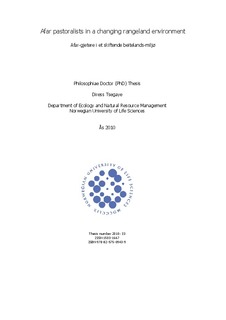| dc.description.abstract | Pastoralists have been using arid and semi-arid rangelands to produce their livelihood outputs through livestock production for centuries. However, recent changes in land use and associated impacts on biodiversity and peoples’ livelihood contributed to the growing crisis of pastoralism in Africa. This study was thus aimed at understanding the patterns of land-use changes (and consequences) that pose threats to key resources and peoples’ livelihood in northern Afar rangelands, Ethiopia. In addition, the recruitment dynamics of an important food and fodder plant, Dobera glabra (Forssk.) Poir, was examined.
The results in this thesis are based on several methods that include a combination of remote sensing data (Paper I), perceptions of local people (Paper I and II), comparative descriptions of abundance and population structure of D. glabra in habitats with different land use histories (Paper III), and manipulative nursery and field experiments (Paper IV and V). Combining patterns of land-use/cover change with the processes underlying the change helps in understanding when, how, and why the changes are taking place in the landscape.
The results in this thesis revealed that rangelands in northern Afar have changed considerably during the past 35-years between 1972 and 2007, in that 47% of the total area changed land cover type (Paper I). The general trend observed implies a loss of grassland and woodland cover and an increase in cultivated area and bushland cover. If the present landuse/ cover change continues, coupled with a drier climate, people’s livelihoods will be greatly affected and the pastoral production system will come under an increasing threat. The findings in this thesis also demonstrate that all households in the study area were generally poor and the Afar pastoralists are in transition to a sedentary life through increasing involvement in farming and non-farm/non-pastoral activities (Paper II). Although pastoralism has traditionally been the major economic activity for the Afar society and is the main reason for continuing the practice, households specializing only in livestock earn less income compared to those who practice farming or both in recent years.
This thesis also constitutes the first step in understanding the recruitment status of the important food and fodder plant, D. glabra in Afar rangelands (Papers III-V). The findings indicate that natural recruitment of D. glabra is unlikely with the existing continuous and intensive grazing/browsing coupled with a drier climate. Although moisture is not a crucial limiting factor for seedling growth, it may lead to a narrow window of opportunity for D. glabra regeneration from seeds. Dobera glabra may only be sustained if protective measures are put in place in some key range sites where it is commonly occurring. | nb_NO |

